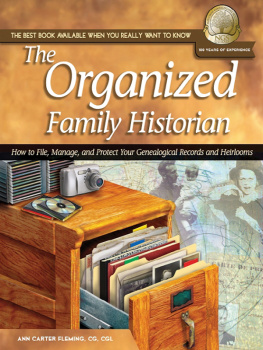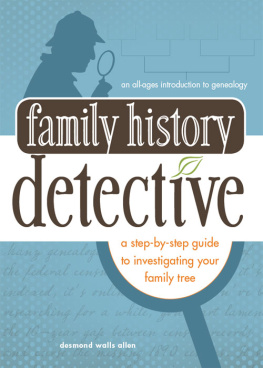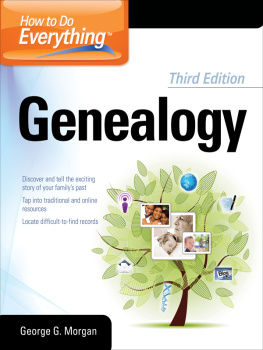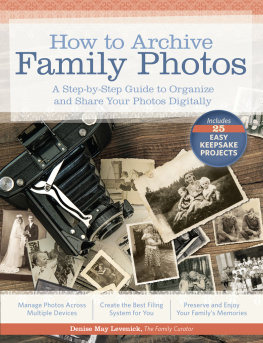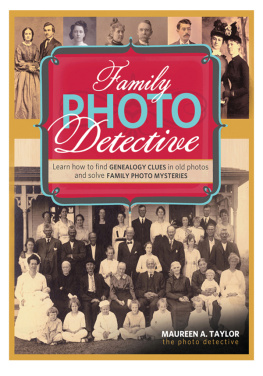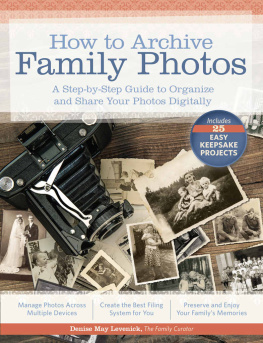How to Archive Family Keepsakes
Learn How to Preserve Family Photos, Memorabilia & Genealogy Records
Denise May Levenick
The Family Curator

Cincinnati, Ohio
shopfamilytree.com
Introduction
THE ROLE OF THE FAMILY CURATOR
In every family, someone ends up with the stuff. I had my first glimpse at a family archive when I was about seven years old. My elderly grandmother Arline held me by the hand to lead me into a shadowy back room that smelled of cologne and BENGAY ointment. She reached under a bureau and pulled out an old-fashioned suitcase, leaving a trail of dust on the wooden floor. I held my breath as she flipped open the metal latches, certain that great treasures would be revealed inside. But instead of jewelry or etched silver, all I saw was paper, paper, and more paper filling the interior.
Grandma sifted through the old letters, receipts, bankbooks, and loose papers until she found what she wanted to show mea yellowing newspaper with screaming headlines. It was a news story about my grandmother and the brazen daytime child-snatching of her first daughter, my great-aunt Lucile. The suitcase filled with crumbling newsprint had taken on a whole new meaning; here was treasure after all.
I have always liked old things, so my grandmothers papers held a special fascination for me. Without any special fanfare or fuss, my family seemed to assume that I would be The Family Curator, the keeper of the stuff.
By the time I inherited Arlines Archive in 2000, my grandmother had passed away, and all her papers had been moved to a large steamer trunk stored in a small, unheated office adjacent to my aunts garage. Aside from the few days when I was allowed to borrow several items for a college paper, the trunk remained closed for thirty-five years.
When we finally lifted the lid of the large travel trunk, we saw absolute chaos inside. It looked as though someone had quite literally opened Grandma Arlines treasure-filled suitcases and dumped the contents into the large empty cavity of the trunk. There was no organization at all. Old photographs were lying next to bankbooks on top of letters, rent receipts, and blue chip stamps. Buttons, earrings, and metal curlers were mixed amongst the layers.
Most family archives arent found in libraries or museums. Instead, like my grandmothers collection, theyre found in suitcases, boxes, trunks, and drawers tucked away in attics, basements, garages, and even under beds.
Some storage places arent bad environments for long-term storage, but many, especially attics and basements, are death zones for artifacts. The trunk had provided a relatively sealed environment for Arlines treasures, keeping things free from dust, damp, and vermin; but anything in the uninsulated room was subjected to the Southern California climate, which fluctuates from freezing to triple digits. Fortunately, the trunk must have been closed during dry weather; there was no trace of damp or mildew.
My first instinct was to sort and then store everything, but I learned that was not always the best way to work with a family archive. Organizing too soon can be as disastrous as poor storage. I certainly wasnt a professional archivist; I didnt even consider myself very good at organizing. I wasnt quite sure how to approach the project.
An entire life had been poured into a box and I needed help managing it. I wanted to know how to untangle the stories hiding in those documents, letters, and photos.
I set about learning best practices for working with historical materials, but couldnt find the information I needed. Genealogists were mostly concerned with organizing pedigree charts or preserving vital records; collectors dealt with artifacts like quilts, samplers, or military memorabilia; photographers focused on digitizing images. I learned something from each field, but I still wanted help working with an entire project.
The professional world of libraries and museums offered guidance in working with larger collections, which seemed closer to my goal, but they had knowledge, funds, and staffing that I didnt have. As I read more about archival practices, I discovered more questions:
What should I do first?
Should I sort or organize?
Should I move everything into archival storage?
Should I scan and digitize everything?
Should I make photocopies?
Should I keep everything?
What could I throw away?
I started using my word processor to keep notes on archival standards, how to care for various heirlooms, and what kinds of documents were important for genealogical research. Before long, I was drowning in information but still not making much progress in coming up with a realistic game plan to work with Arlines Archive. I knew what to do, but I didnt know how to begin.
On top of it all was the reality that I was a high school teacher with a busy family life. My grown sons were off at college and jobs, but home often enough that I wanted to be available for them and for our extended family. I helped my husband with office work for his business and enjoyed my volunteer commitments. My genealogy work was pretty well confined to school vacations and summers; I didnt have the time or resources to become a full-time archivist.
I was growing increasingly frustrated and discouraged, when I was struck by a true aha moment. I suddenly realized that I no longer thought of my inheritance as my grandmothers stuff, but now looked at the contents of the trunk as The Arline Allen Kinsel Papers. My grandmothers things were just as much an official archive as any family history collection in the Smithsonian Museum.
Arlines letters, photos, and memorabilia all spoke of a fascinating story, but I didnt have to give up my life to be the permanent caretaker of her possessions. I found that by adapting professional methods for a family archive, I could confidently sort through my grandmothers treasures and discover the stories they held. I could more comfortably make decisions about items worth preserving and I could wisely invest the resources I had available for the project. I was in charge of the stuff instead of the other way around.
Since opening my grandmothers trunk, I have become The Family Curator for six more family archives. The largest included five homes filled with personal possessions; the smallest came in a brown paper lunch bag. I wasnt much different than the overworked museum staffers who have to decide how to handle hundreds of new collections. They couldnt possibly process everything immediately, so why should I expect that I could? I realized I could choose just how much sorting, organizing, and transcribing I wanted to do, and set my own timeline.
YOU AND YOUR FAMILY ARCHIVE
You may have boxes filled with treasures, or you may be helping a parent or relative downsize her possessions as she moves to a smaller home. You may even want help making your own family archive more accessible for your children and grandchildren. This book will help you organize your family archive and preserve your family history for future generations regardless of the size of your family history inheritance.
You probably have a busy life filled with many roles and responsibilities, so you dont need one more all-consuming project. You also dont need a lot of guilt simply because you choose not to spend your life caring for other peoples possessions. Thats why Ive pulled together what Ive learned to make your work as the family archivist as easy as possible.


